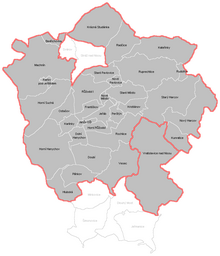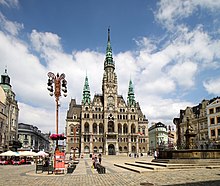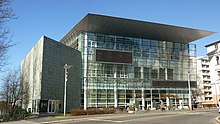Liberec
Liberec | |
|---|---|
 View from the city hall tower | |
 Flag  Coat of arms | |
 Liberec Location in the Czech Republic | |
| Coordinates: 50°46′N 15°4′E / 50.767°N 15.067°ECoordinates: 50°46′N 15°4′E / 50.767°N 15.067°E | |
| Country | |
| Region | Liberec |
| District | Liberec |
| First mentioned | 1352 |
| Government | |
| • Mayor | (SLK) |
| Area | |
| • Total | 106.09 km2 (40.96 sq mi) |
| Elevation | 374 m (1,227 ft) |
| Population (2021-01-01)[1] | |
| • Total | 104,261 |
| • Density | 980/km2 (2,500/sq mi) |
| Time zone | UTC+1 (CET) |
| • Summer (DST) | UTC+2 (CEST) |
| Postal code | 460 01 |
| Website | www |
Liberec (Czech: [ˈlɪbɛrɛts] (![]() listen); German: Reichenberg [ˈʁaɪçn̩bɛʁk]) is a city in the Czech Republic. It has about 104,000 inhabitants and it is the fifth-largest city in the country. It lies on the Lusatian Neisse and is surrounded by the Jizera Mountains and Ještěd–Kozákov Ridge. The town centre is well preserved and is protected by law as an urban monument zone.
listen); German: Reichenberg [ˈʁaɪçn̩bɛʁk]) is a city in the Czech Republic. It has about 104,000 inhabitants and it is the fifth-largest city in the country. It lies on the Lusatian Neisse and is surrounded by the Jizera Mountains and Ještěd–Kozákov Ridge. The town centre is well preserved and is protected by law as an urban monument zone.
Liberec was once home to a thriving textile industry and hence nicknamed the "Manchester of Bohemia". For many Czechs, Liberec is mostly associated with the city's dominant Ještěd Tower. Since the end of the 19th century, the city has been a conurbation with the suburb of Vratislavice nad Nisou and the neighbouring city of Jablonec nad Nisou. Therefore, the total area with suburbs encompasses 150,000 inhabitants.
Administrative parts[]

Liberec is made up of 32 city parts and one self-governing borough (Vratislavice nad Nisou).
- Staré Město (Liberec I)
- Nové Město (Liberec II)
- Jeřáb (Liberec III)
- Perštýn (Liberec IV)
- Kristiánov (Liberec V)
- Rochlice (Liberec VI)
- Horní Růžodol (Liberec VII)
- Dolní Hanychov (Liberec VIII)
- Janův Důl (Liberec IX)
- Františkov (Liberec X)
- Růžodol I (Liberec XI)
- Staré Pavlovice (Liberec XII)
- Nové Pavlovice (Liberec XIII)
- Ruprechtice (Liberec XIV)
- Starý Harcov (Liberec XV)
- Nový Harcov (Liberec XVI)
- Kateřinky (Liberec XVII)
- Karlinky (Liberec XVIII)
- Horní Hanychov (Liberec XIX)
- Ostašov (Liberec XX)
- Rudolfov (Liberec XXI)
- Horní Suchá (Liberec XXII)
- Doubí (Liberec XXIII)
- Pilínkov (Liberec XXIV)
- Vesec (Liberec XXV)
- Hluboká (Liberec XXVIII)
- Kunratice (Liberec XXIX)
- Vratislavice nad Nisou (Liberec XXX)
- Krásná Studánka (Liberec XXXI)
- Radčice (Liberec XXXII)
- Machnín (Liberec XXXIII)
- Bedřichovka (Liberec XXXIV)
- Karlov pod Ještědem (Liberec XXXV)
In the early 1990s, some of parts became independent municipalities: Stráž nad Nisou (formerly Liberec XXVI-Stráž nad Nisou and Liberec XXVII-Svárov), Dlouhý Most (formerly Liberec XXXVI-Dlouhý Most), Jeřmanice (formerly Liberec XXXVII-Jeřmanice) and Šimonovice (formerly Liberec XXXVIII-Minkovice and Liberec XXXIX-Šimonovice).
Etymology[]
The origin of the city name was the subject of many discussions, often nationally influenced, because it was a bilingual settlement.
The oldest known names of the city are German, Reychinberch (1352) and Raichmberg (1369), meaning "rich/resourceful mountain" (reicher Berg in modern German). It was also named Reichenberg (1385) and Rychmberg (1410).
The Czech equivalent originated as a distortion: Rychberk (1545), Lychberk (1592), Libercum (1634), Liberk (1790), and finally Liberec (1845). In Czech, words starting with "R" were often dissimilated into "L". Since then, the city was known as Liberec in Czech and as Reichenberg in German.
History[]


Probably at the end of the 13th century, a settlement was established on the trade route from Bohemia to Lusatia. Liberec first belonged to the Bieberstein and Redern families and was first mentioned in a document of 1348. When the Redern family after the Battle of White Mountain was forced to leave Liberec, it was acquired by Albrecht von Wallenstein. After his death it belonged to the Gallas and Clam Gallas families. The cloth-making industry was introduced in 1579. The prosperous local industry was interrupted by the Thirty Years' War and a great plague in the 1680s. The Battle of Reichenberg between Austria and Prussia occurred nearby in 1757 during the Seven Years' War.
Until 1918 the city was part of the Kingdom of Bohemia, Austrian monarchy (Austrian side after the compromise of 1867), seat of the Reichenberg district, one of the 94 Bezirkshauptmannschaften in Bohemia.[2]

At one time the second city of Bohemia,[3] the city developed rapidly at the end of the 19th century and as a result has a spectacular collection of late-19th-century buildings; the city hall, the opera house and the North Bohemian Museum are of note. The Opera House has a spectacular main curtain designed by the Austrian artist Gustav Klimt. The neighbourhoods on the hills above the city centre display beautiful homes and streets, laid out in a picturesque Romantic style similar to some central European thermal spas.
After the end of World War I Austria-Hungary fell apart. The Czechs of Bohemia joined newly established Czechoslovakia on 29 October 1918 whilst the Germans wanted to stay with Austria to form reduced German Austria on 12 November 1918, both citing Woodrow Wilson's Fourteen Points and the doctrine of self-determination. Reichenberg was declared the capital of the German-Austrian province of German Bohemia. Czechs however argued that these lands, though German-settled since the Middle Ages, were historically an integral part of the Duchy and Kingdom of Bohemia. On 16 December 1918 the Czechoslovak Army entered Reichenberg and the whole province remained part of Bohemia.
In the 1920s and the 1930s, Liberec became the unofficial capital of Germans in Czechoslovakia, a position was underlined by the foundation of important institutions such as , a central German library in Czechoslovakia, and by failed efforts to relocate the German section of the Charles University there from Prague.
The Great Depression devastated the economy of the area with its textile, carpet, glass and other light industry. The high number of unemployed people, hunger, fear of the future and dissatisfaction with the Prague government led to the flash rise of the populist Sudeten German Party (SdP), founded by Konrad Henlein, born in the suburbs of Liberec. Whilst he declared fidelity to the Republic, he secretly negotiated with Adolf Hitler. In 1937 he radicalized his views and became Hitler's puppet in order to incorporate the Sudetenland into Germany and destabilize Czechoslovakia, which was an ally of France and one of the leading arms producers in Europe.
The city became the centre of Pan-German movements and later of the Nazis, especially after the 1935 election, despite its important democratic mayor, (German Democratic Freedom Party). The final change came in Summer 1938, after the radicalization of the terror of the SdP, whose death threats forced Kostka and his family to flee to Prague.
In September 1938, after two unsuccessful attempts by the SdP to stage a pro-Nazi coup in Czechoslovakia, which were stopped by police and the army, the Munich Agreement awarded the city to Nazi Germany and it became the capital of Reichsgau Sudetenland. Until 1945, the city was administered as a part of the Regierungsbezirk Aussig of Reichsgau Sudetenland. Most of the city's Jewish and Czech population fled to the rest of Czechoslovakia or were expelled. The important synagogue was burned down. Henlein himself confiscated a villa in Liberec that had belonged to a Jewish businessman, which remained Henlein's home until 1945.[4] During a rally in December 1938, Hitler laid out the future of the Hitler Youth.[5]
After World War II the city again became a part of Czechoslovakia and nearly all of the city's German population was expelled following the Beneš decrees. The region was then resettled with Czechs, completely altering the traditional language and culture of the city and its region. The city continues to have an important German minority, consisting of descendants of anti-Nazi Germans who were active in the struggle against Hitler, as well as Germans from Czech–German families and their descendants. Liberec also has a Jewish minority with a newly built synagogue and a Greek minority, originating from Communist refugees who settled there after the Greek Civil War in 1949.
Demography[]
|
|
| ||||||||||||||||||||||||||||||||||||||||||||||||||||||
| Source: Historical lexicon of municipalities of the Czech Republic[6] | ||||||||||||||||||||||||||||||||||||||||||||||||||||||||
Transport[]

Liberec city transport provides bus and tram lines. The first tram was used in Liberec in 1897. Liberec shares the 1,000 mm (3 ft 3+3⁄8 in) metre gauge tramway line which connects it to its neighbouring city, Jablonec nad Nisou which is 12 km away. There are also two city lines with 1,435 mm (4 ft 8+1⁄2 in) standard gauge: The first connects Horní Hanychov (not far to the cable car to Ještěd) and Lidové Sady via Fügnerova. The second connects Dolní Hanychov and Lidové Sady via Fügnerova (only during workdays). There are also four historical trams. In the city centre there are two tracks as a memorial, in the past trams were used also on the central place in front of the city hall. A private international airport is located in the Liberec part of Ostašov.
Education and science[]

Technical University of Liberec was founded in 1953 as " University of Mechanical Engineering in Liberec". After the number of fields has grown, in 1995, the university was renamed. It is known especially for its research in the field of textile engineering.[7] It has about 9,000 students in 6 faculties (Mechanical Engineering, Textile Engineering, Arts and Architecture, Mechatronics Informatics and Inter-Disciplinary Studies, Science-Humanities and Education, and Economics), and it also comprises Institute for Nanomaterials, Advanced Technologies and Innovation.[8]
Regional Research Library in Liberec is a general public science library, aiming at general education in the region. Founded in 1900, based on the decision of the municipal council to establish a municipal library. It has an exceptional collection of Germano-Slavica and Sudetica (periodicals and books in German language from Bohemia). New building was completed in 2000 on the site of the Old Synagogue, which was burnt down by the Nazis in November 1938. Its building comprises also a modern New Synagogue.
Culture[]
Mateřinka is a theatre festival biennially held in June.
Sport[]

The city is home to FC Slovan Liberec, a football club founded in Liberec which plays in the Czech First League, the top tier. Slovan Liberec is one of the most successful clubs in the Czech Republic, having won three league titles. There is also SK VTJ Rapid Liberec. It is playing one of the lowest division.
The ice hockey team HC Bílí Tygři Liberec play in the Czech Extraliga, the national top tier. It plays in Home Credit Arena.
Liberec has hosted two European Luge Championships, having done so in 1914 and 1939. In 2009, it hosted the FIS Nordic World Ski Championships. The Ski Jumping World Cup always comes to Liberec in January. The World Karate Championships took place in May 2011.
In 2015, from 15 to 23 August, Liberec plays host to the 2015 World Mountain Bike Orienteering Championships (WMTBOC).
Sights[]

Liberec's prominent buildings are the City Hall (1893), the Liberec Castle (Liberecký zámek), built in the 16th century, and the Ještěd Tower (1968) upon the Ještěd Mountain, build by architect Karel Hubáček, which became a symbol of the city. Václav Havel held a broadcast from the site of the tower in 1968; a plaque beside the tower marks this event.
Contemporary buildings of note are also to be found, primarily the work of the firm SIAL, and include the new Regional Research Library (2000) and the Česká Pojišťovna office building (1997). Neo-Renaissance F. X. Šalda theatre was built in 1871–1872. Centrum Babylon Liberec include a large water park, an amusement park, a casino, shopping court and hotel.
The North Bohemian Museum was built in 1873. It ranks among the oldest and most significant museums of nature sciences, arts and crafts in the Czech Republic. There is the sculpture of T. G. Masaryk from 2010 standing in front of the Museum.
Zoo and botanical garden[]

The Liberec Zoo was the first to be opened in Czechoslovakia in 1904. The zoo contains a wide variety of fauna (about 143 species on 13 ha), including large mammals like elephants, giraffes, sea lions and white tigers, which are a genetic anomaly and hence very rare. It participates in breeding activities of endangered species to help preserve the gene pool.
The Botanical Garden in Liberec (completely rebuilt from Kučera 1995 to 2000) comprises nine glasshouses for visitors (with a total area of 3,000 m2 (32,291.73 sq ft) and 13 exhibition themes), nine plantation glasshouses and a large exterior terrain. It continues the legacy of a botanical garden established in 1876 by the Verein der Naturfreunde ("Society of Friends of Nature") on a nearby site and it is therefore considered the oldest one in the Czech Republic.
Notable people[]
- Christoph Demantius (1567–1643), composer and poet
- Joachim Johann Nepomuk Spalowsky (1752–1797), naturalist
- Josef Proksch (1794–1864), composer and teacher of Bedřich Smetana
- Friedrich Karl Ginzel (1850–1926), astronomer
- Heinrich Herkner (1863–1932), economist
- Ferdinand Porsche (1875–1951), car designer
- Vlasta Burian (1891–1962), actor
- Edmund Nick (1891–1973), composer
- Jaroslav Řídký (1897–1956), composer
- Konrad Henlein (1898–1945), Nazi politician
- Emil Artin (1898–1962), mathematician
- Arthur Beer (1900–1980), astronomer
- Harald Kreutzberg (1902–1968), dancer and choreographer
- Herbert Feigl (1902–1988), philosopher
- Guido Beck (1903–1989), physicist
- Augustin Schramm (1907–1948), communist politician and officer
- Roderich Menzel (1907–1987), tennis player
- Fritz Preissler (1908–1948), luger
- Egon Hartmann (1919–2009), architect
- Otfried Preußler (1923–2013), writer
- Markus Lüpertz (born 1941), artist
- Barbara Bouchet (born 1944), actress and entrepreneur
- Oldřich Kaiser (born 1955), actor
- Vladimír Šlechta (born 1960), writer
- Jaroslav Nedvěd (born 1969), ice hockey player
- Petr Nedvěd (born 1971), ice hockey player
- Martin Damm (born 1972), tennis player
- Tomáš Enge (born 1976), F1 driver
- Jan Víšek (born 1981), ice hockey player
- Yemi A.D. (born 1981), choreographer and artist
- Lukáš Derner (born 1983), ice hockey player
- Pavla Havlíková (born 1983), cyclist
- Zuzana Hejnová (born 1986), athlete
- Martin Cikl (born 1987), ski jumper
Twin towns – sister cities[]
Liberec is twinned with:[9]
 Amersfoort, Netherlands
Amersfoort, Netherlands Augsburg, Germany
Augsburg, Germany Nahariya, Israel
Nahariya, Israel Zittau, Germany
Zittau, Germany
Gallery[]

View of Liberec from Ještěd

Ještěd mountain with Ještěd TV tower and hotel

The F. X. Šalda Theatre
Closest cities, towns and villages[]
References[]
- ^ "Population of Municipalities – 1 January 2021". Czech Statistical Office. 30 April 2021.
- ^ Die postalischen Abstempelungen auf den österreichischen Postwertzeichen-Ausgaben 1867, 1883 und 1890, Wilhelm Klein, 1967
- ^ Di Duca, Marc. Bradt's Czech Republic (2006)
- ^ Cornwall, Mark (2011). The Czechoslovak Spinx: 'Moderate and Reasonable' Konrad Henlein. London: I.B.Tauris. pp. 206–227. ISBN 1780768087.
- ^ Anna Rosmus Hitlers Nibelungen, Samples Grafenau 2015, pp.164 f
- ^ "Historický lexikon obcí České republiky 1869–2011 – Okres Liberec" (in Czech). Czech Statistical Office. 21 December 2015. pp. 9–10.
- ^ "Technical University of Liberec". Technical University of Liberec. Retrieved 28 July 2021.
- ^ "Faculties and Institutes". Technical University of Liberec. Retrieved 28 July 2021.
- ^ "Zahraniční vztahy" (in Czech). Statutární město Liberec. Retrieved 4 June 2020.
External links[]
| Wikimedia Commons has media related to Liberec. |
- Official website (in Czech and German)
- Liberec tourist portal
- Facebook page
- Tramway Liberec (in Czech)
- Liberec Botanical Garden
- Liberec Zoo
 Liberec travel guide from Wikivoyage
Liberec travel guide from Wikivoyage- Oblastni galerie v Liberci (Museum of art)
- Unofficial Liberec Trip Planner
- Oblastní galerie Liberec at Google Cultural Institute
- Populated places in Liberec District
- Liberec
- Cities and towns in the Czech Republic
- Holocaust locations in Czechoslovakia



